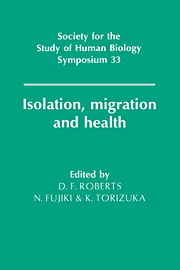Book contents
- Frontmatter
- Contents
- List of contributors
- Preface
- 1 The legacy of the IBP: Presidential Address
- 2 The distinction between primary and secondary isolates
- 3 Time trends in the break-up of isolates
- 4 Factors influencing the frequency of consanguineous marriages in Japan
- 5 Break-up of isolates
- 6 Isolates in India: their origin and characterisation
- 7 Consanguineous marriages and their genetical consequences in some Indian populations
- 8 Biomedical and immunogenetic variation in isolated populations in India
- 9 Genetic distance analyses in Israeli groups using classical markers and DNA polymorphisms in the β globin gene
- 10 Non-random distribution of Gm haplotypes in northern Siberia
- 11 Allele frequency estimation
- 12 Genetic affinities of human populations
- 13 Inherited neurological diseases in island isolates in southern Japan
- 14 Serological and virological evidence for human T-lymphotropic virus type I infection among the isolated Hagahai of Papua New Guinea
- 15 Analysis of genes associated with hypercholesterolaemia in the Japanese population
- 16 Migrant studies and their problems
- 17 Tokelau: migration and health in a small Polynesian society - a longitudinal study
- 18 Micromigrations of isolated Tuareg tribes of the Sahara Desert
- 19 Population structure in the eastern Adriatic: the influence of historical processes, migration patterns, isolation and ecological pressures, and their interaction
- 20 Diabetes and diabetic macroangiopathy in Japanese-Americans
- 21 Diabetes and westernisation in Japanese migrants
- 22 Environmental factors affecting ischemic heart disease
- Epilogue
- Index
18 - Micromigrations of isolated Tuareg tribes of the Sahara Desert
Published online by Cambridge University Press: 05 March 2012
- Frontmatter
- Contents
- List of contributors
- Preface
- 1 The legacy of the IBP: Presidential Address
- 2 The distinction between primary and secondary isolates
- 3 Time trends in the break-up of isolates
- 4 Factors influencing the frequency of consanguineous marriages in Japan
- 5 Break-up of isolates
- 6 Isolates in India: their origin and characterisation
- 7 Consanguineous marriages and their genetical consequences in some Indian populations
- 8 Biomedical and immunogenetic variation in isolated populations in India
- 9 Genetic distance analyses in Israeli groups using classical markers and DNA polymorphisms in the β globin gene
- 10 Non-random distribution of Gm haplotypes in northern Siberia
- 11 Allele frequency estimation
- 12 Genetic affinities of human populations
- 13 Inherited neurological diseases in island isolates in southern Japan
- 14 Serological and virological evidence for human T-lymphotropic virus type I infection among the isolated Hagahai of Papua New Guinea
- 15 Analysis of genes associated with hypercholesterolaemia in the Japanese population
- 16 Migrant studies and their problems
- 17 Tokelau: migration and health in a small Polynesian society - a longitudinal study
- 18 Micromigrations of isolated Tuareg tribes of the Sahara Desert
- 19 Population structure in the eastern Adriatic: the influence of historical processes, migration patterns, isolation and ecological pressures, and their interaction
- 20 Diabetes and diabetic macroangiopathy in Japanese-Americans
- 21 Diabetes and westernisation in Japanese migrants
- 22 Environmental factors affecting ischemic heart disease
- Epilogue
- Index
Summary
If the main objective of anthropology is the study of variation among and within human groups (Gomila, 1976), it is necessary to ‘determine first the structure and distribution of any identifiable units’ (Roberts, 1965). But this task presents difficulties. Such units are fluid. Human populations are groups of living and reproducing entities. Like any living system, they demonstrate a combination of different levels of organisation and integration, primary as cells, secondary as tissues and, yet more complex, tertiary as the whole morphology. Obviously these different levels and their combinations have different functions, the regulation and evolutionary meaning of which have barely been explored.
It is convenient to distinguish two different levels of population organisation and structure (Lefevre-Witier, 1976). A first level of discontinuity is that of the ‘genetic population’. This consists of the mating circle and the circle of fertile offspring. This definition differs from that of isolates of Dahlberg (1948) which concerns mating only; from that of the panmictic mendelian populations of Dobzhansky (1970) which extends the circle up to panmixia but excludes mate selection; and from the isogamic population of Malecot (1966) which also excludes selection. These three have in common a human group where the maximum of gametic transmission and exchange occurs as well as a strong tendency to genetic homogeneity; the principal limitations are the absence of differential fertility and infant mortality generation by generation expressing the action of natural selection. Our definition is more comparable to the endogamic circle of Henry (1968) and the natural effective population of Wright (1946).
- Type
- Chapter
- Information
- Isolation, Migration and Health , pp. 192 - 203Publisher: Cambridge University PressPrint publication year: 1992
- 2
- Cited by

